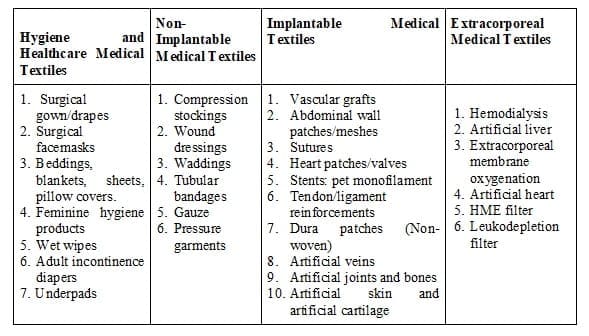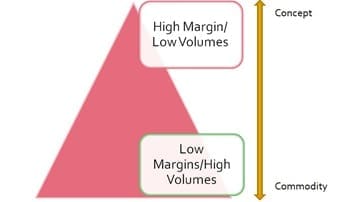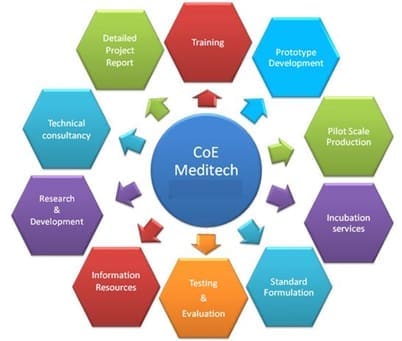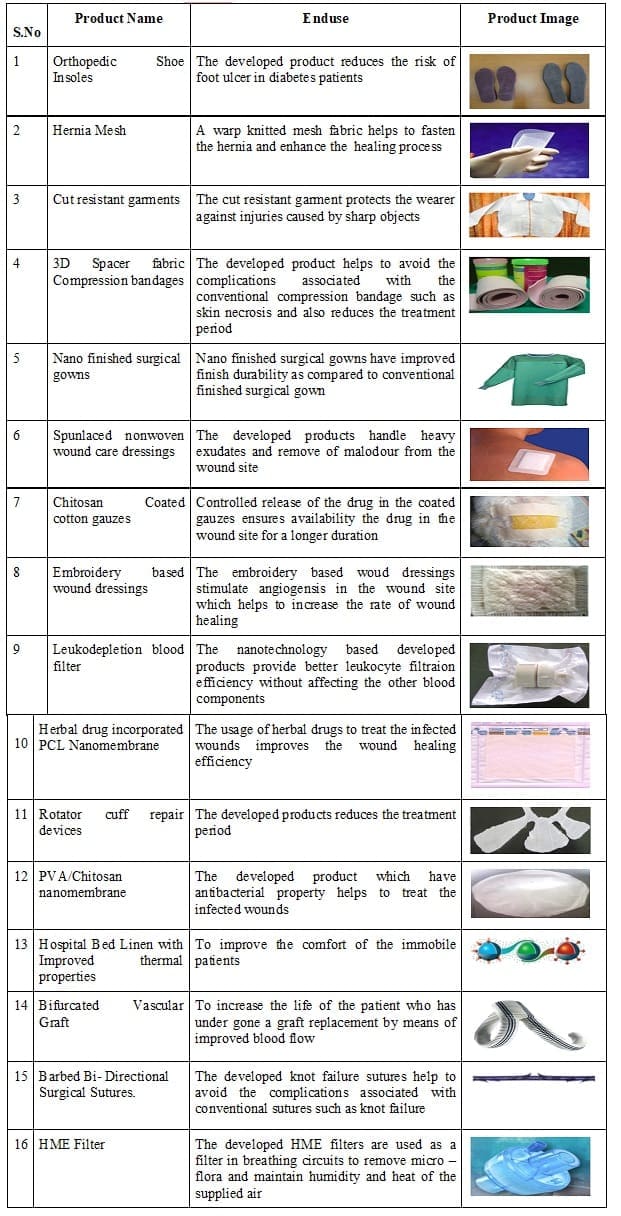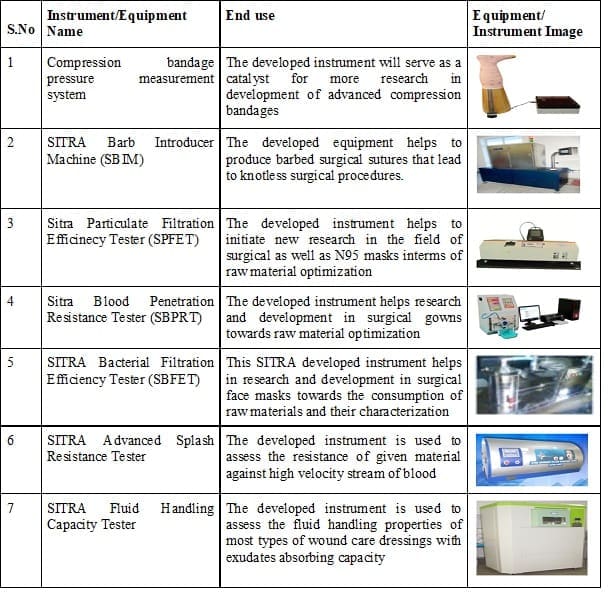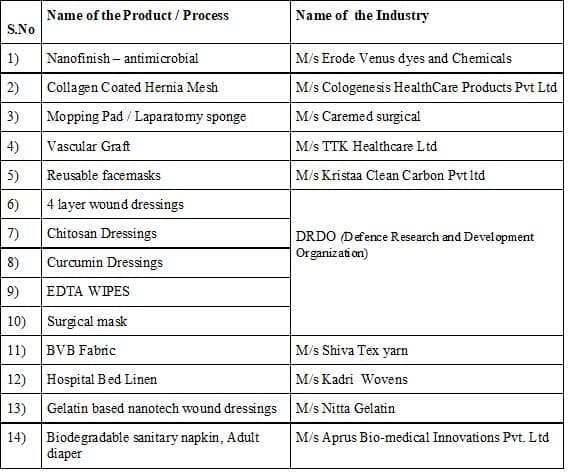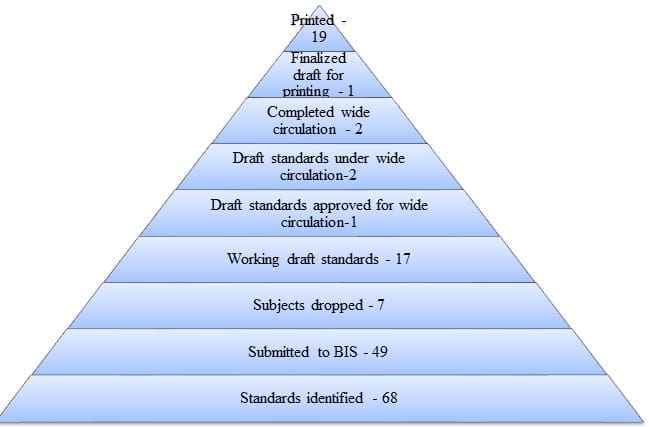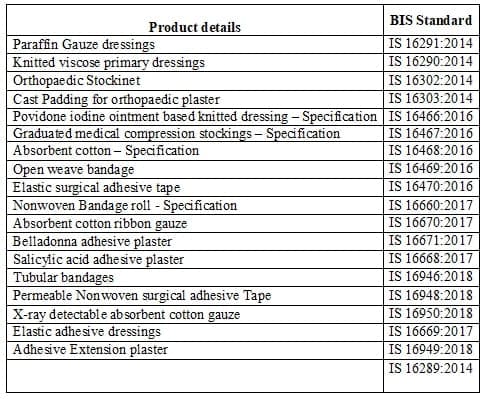A Sun Rise Industry and role of Centre of Excellence SITRA in promotion of Medical Textiles
Ketankumar Vadodaria,* E. Santhini, T. Suresh ram, Abhilash Kulkarni,
D. Veerasubramanian and K. Agalya Devi.
The South India Textile Research Association, Coimbatore, India
Abstract
India is the second largest player in textiles after China. But when it comes to technical textiles where almost 16 different fields have been identified, India is still an infant. Medical textiles is one of the fastest growing technical textile fields in India and across the globe. Medical textiles is a sunrise industry. Medical textiles comprises of as simple products such as wipes to life saving and more complex products such as vascular grafts. India being second largest populous country in the world, with more baby birth rates and increase in average lifespan, the demand for medical textiles is going to increase year on year. Moreover, capabilities to produce cost effective medical textile products opens up doors of the international market also. The paper presents an introduction, classification, scope and challenges in the field of medical textiles.
Key Words: Technical Textiles, Medical Textiles, Opportunities, Market
1. INTRODUCTION
Medical textiles is one of the fastest growing technical textile fields in India. Technical textiles are the textiles developed and manufactured textiles to meet specific functional properties for specific end use, engineered required by combining properties of different textile structures and materials. Below is the Classification list of technical textiles:
Medical textiles hygiene and medical (Healthcare Textiles)
Agro Tech agriculture, aquaculture, horticulture and forestry
Build Tech building and construction
Cloth Tech technical components of footwear and clothing
Geo Tech geotextiles and civil engineering
HomeTech technical components of furniture, household textiles
Indu Tech filtration, conveying, cleaning and other industrial uses
MobilTech automobiles, shipping, railways and aerospace
Oeko Tech environmental protection
Pack Tech packaging components
Pro Tech personal and property protection
Sport Tech sport and leisure
- Classification of medical textile products
Medical textiles are those technical textiles in day to day life for maintaining hygienic & health conditions as well as in assisting / performing medical | surgical procedure including inplantables.
- Corresponding author: coemed@sitra.org.in; lab.bd@sitra.org.in.
Medical textiles can be divided into:
- Consumer products – Eg: Sanitary napkins, baby diapers, wipes, adult diapers
- Hospital products – Eg: Surgical gowns, surgical drapes
Medical textiles is classified into 5 categories
- Implantable :- inside the patient’s body
- Non-Implantable :- on the patient’s body
- Extracorporeal device :- Besides the patient’s body
- Healthcare textiles :- For the body (Usually hospital products)
- Hygiene textiles :- for the body (Usually consumer products)
2.1 List of products in all sectors
3. Features of medical textiles
The desired features of medical textiles would be
- High levels of breathability/Non breathability/barrier performance
- Hydrophilic/ Hydrophobic
- Broad spectrum of antimicrobial resistance such as bacteria, viral, fungal, mould resistance etc
- Biocompatibility
- Cell adhesion/Cell non-adhesion surface
- 2 D & 3 D structures
- Sterilability
- Biodegradable/Non biodegradable
- Elasticity/non elasticity
- Strength
4. Textile structure in Medical textiles
Medical textile products can be made from each stage of textile manufacturing. Textiles structuring is broadly divided into 4 categories: – fabric, yarn, fabric and garments.
Product such as surgical cotton, wadding, ear buds, etc., is produced directly from textile fibres. Products such as sutures, heart valve stitching thread, dental floss, dialysis membrane filaments produced gram filament / yarn etc. In fabric structure there is further classification in terms of woven (vascular graft, reusable bed sheets & pillow covers), non woven (surgical gowns, disposable bed sheets & pillow covers), knitted (vascular graft, hernial mash, heart patch fabric), braded (Anterior cruciate ligament sutures etc), (rotator cuff). All the operational theatre garments come under stitched garment products (surgical gowns, bed sheets, etc), products made up of different textile structure (sanitary napkin/under pad, fibers of non woven, wound dressing – fibers + woven/non woven/knitted structure, etc.
5. Overall opportunities in medical textiles
Opportunities lies in technical textile machine manufacturing, specialised raw material manufacturing, setting up laboratories to test these materials /products, manpower training, etc.
- Many medical textile products are imported and not manufactured in India, so there is a huge potential for manufacturing them in India. Many medical textiles products are classified as medical devices. There is no concrete data available for medical textiles, but 80% of medical devices are imported.
- Though India is the second most populous country, the penetration of medical textiles is very less in India due to factors such as less awareness among people, cost of products and non availability of many products to common people. But now the usage of medical\ technical textiles is increasing due to the new generation with a higher disposable income, more education, easy access to media/internet.
- Higher child birthrates – mother and child.
- Medical tourism – Cost of getting treated is cheaper and faster compared to the developed countries.
- More modern hospitals are coming up, so growth of medical textiles is proportional by hiked with growth of medical business.
- Increased awareness for Medical insurance. Medical insurance companies insist hospitals to maintain a proper environment to reduce risk of HAI.
- The shift in Indian culture to western influence and globalisation has created / helped in creating more awareness about usage of medical textiles in day-to-day life such as wipes, sanitary napkins, diapers to maintain cleanliness & hygiene environment.
- Many medical textiles are used for maintaining an hygienic environment. Young Indians are interested in more comfort and cleanliness.
- Availability of almost all basic raw materials in India.
- Mandating suggestions by GOI in different ministries such as MoD, MoHFW, MoLE, MoR, MoHA.
- Government initiatives by creating centres of excellence in different fields of technical textiles. Formation of Centre of excellence for medical textile at SITRA has helped industry in many areas such as R&D, standard formation, testing/ characterisation etc.
- Proactive approach of government towards boosting TT sectors by different government scheme for business community in terms of subsidies, special zones (Meditech zone, Visakhapatnam), ATUF, TMTT, etc as well as promotion of the TT scheme by every state government.
- Government is planning to mandate a few products as per BIS standards; this will help to eliminate usage of substandard products (manufactured or imported).
- Creating awareness such as distribution of free napkins by many NGOs as well as government agencies
- Cheap labour and abundance of manpower, cheap power compared to many countries can help manufacturing cheaper medical textile products.
- Mandating purchase from MSMEs
- Schemes such as Swachh Bharat Abhiyan, Ayushman Bharat.
- M/C manufacturing for medical textiles such as Sanitary napkin making ,face mask making m/c etc have potential to grow huge.
6. Sector wise opportunities in medical textiles
6.1 Implantable
Usually not many life saving products are manufactured in India. India is almost fully dependant on imports. Ultimately, very costly products are not affordable to an average Indian. If invented and manufactured by Indian companies, the cost may come down drastically. Lives of many Indians can be saved. Though the demand is low and the regulatory requirements are stringent, the profit margins are high.
6.2 Non-implantable
These are the products that are used on the skin. Low profit but high demand.
6.3 Extracorporeal devices
Same as Implantable life saving and again very costly products dependent highly on imports. Though the demand is low and the regulatory requirements are stringent, the profit margins are high.
6.4 Hygiene textiles
Not much dependant on imports but still MNCs of foreign origin have considerable stake compared to the Indian manufacturers. Demand is high and investment required is low.
6.5 Healthcare textiles
Not much dependant on imports but still MNCs of foreign origin have considerable stake compared to Indian manufacturers. Demand is high and investment required is low.
compared to Indian manufacturers. Demand is high and investment required is low.
7. Challenges for medical textile business
- Medical device products may require license to produce or sell products in India (New medical device rule is implemented recently).
- And still classification of medical textiles under different categories as medical devices will take time.
- Still many medical products are needed to be classified as medical devices. It may have impact on the small scale industry.
- Lack of standards – So far, SITRA has identified many medical textile products and have developed standards for those.
- Non availability of expertise for the manufacture of specialised raw materials Kevlar, Nylon66, Aramid, etc., and machinery manufacturing techniques in India.
- Lack of interest, awareness and confidence among big industries to enter into the Medical Textile business.
- Scattered industry.
- Lack of trained skilled manpower with interdisciplinary knowledge.
- Disposal of medical textile wastes.
- Cheap import from neighbouring countries such as Bangladesh, China due to reasons such as lack of BIS standards.
8. Initiatives required
Government can incentivize manufacturing in terms of a) Converting and b) Rolled goods manufacturing for development of more customized entrepreneurial activity. An entire ecosystem of R&D, market linkages (treaty), incubation services, easy terms in technology development and manufacturing for global markets can be developed.
- Development of new Infrastructure; more specialized zones such as Medtech Zone in Visakhapatnam.
- Focus on Indian IPR regime
- The Government should strengthen India’s IPR regime through development of highly equipped patent offices and provision of online patent filing facility.
- More tax incentives & subsidies by government from raw materials to final production, machine imports, machine spares and machine manufacturing
- Organising or funding to organize more buyers to seller meets at domestic exhibitions as well as international levels.
- Identifying the potential and existing medical textile manufacturing clusters and help them to produce, test and market their products
- Incentivise MSMEs who are making medical textiles by offering benefits under schemes such as TUF.
For a better entrepreneurial resurgence, incentives should be provided to develop more indigenous machines. Subsidy to develop machines and technology and offering the same at rebated rates for easy paybacks for the startups.
9. Statistics on medical textiles in India
The total market size of medical textiles was $600 million in 2014 and reached $780 million by 2017 growing at 8-9% CAGR.
In 2014, surgical dressings and surgical sutures alone accounted for more than 50 per cent at $380. Universal health coverage scheme, 100 per cent FDI under automatic route and support to PPP model to improve availability of health care services are among the initiatives which will have an impact on consumption.
The medical textile market in India was at around $600 million in 2014, of which surgical dressings and surgical sutures alone accounted for about more than 50 per cent at $380. Universal health coverage scheme, 100 per cent FDI under automatic route and support to PPP model to improve availability of health care services are among the initiatives which will impact consumption (Medical textiles set to grow at 9% CAGR in India, ITJ, September, 2015).
The market for medical textiles, segment-wise is given in the following table. (R. Alagirusamy and A. Das, 2010, Technical textile yarns-Industrial and medical applications, Woodhead publishing limited, UK).
10. Role of SITRA as a Centre of Excellence in Medical Textiles
Our national / International clients include textiles covering both conventional textiles, technical as well as non-textile units, manufacturing industries, traders, universities, individuals, defence, government agencies, etc. The basic services offered by CoE – Medical Textiles are as below
10.1 Testing and Evaluation
CoE-Medical Textiles has Analytical, Physical, Microbiological and Biotechnology, Material Characterization and tissue culture laboratories with high end equipment such as GCMS, LCMS, HPTLC, FeSEM, etc. The centre provides testing facilities as per national / international standards such as BIS, ISO, ASTM, DIN, Kenyan standards, etc. The laboratories are one of the best of its kind in the world, with NABL Certification as per ISO 17025 with well qualified and experienced staff.
11. Technical consultancy
SITRA scientists regularly provide consultancy in different areas of medical textile products/manufacturing/quality process, etc. So far more than 60 technical consultancies have been provided by SITRA CoE.
12. Research and Development
SITRA has well-equipped research laboratories with qualified scientific staff to carry forward R & D in the field of medical / technical textiles. Considering the highly inter-disciplinary nature of research, SITRA has well qualified scientists team of Ph.Ds, Masters, Bachelors, Diploma holder’s from various disciplines such as textiles technology / engineering, chemistry, medical textiles, microbiology, bio-technology, biochemistry, polymer chemistry, analytical chemistry. The scientists aim to develop various medical textile / Technical textile products by developing different textile structures, materials, and processes. SITRA has developed many products using in-house funding or by contract-based research with industry partners or by getting funding from public / private agencies.
Few of the products developed at SITRA are listed below:
Some of the Instruments developed at SITRA are as listed below:
SITRA CoE has published more than 45 research articles in reputed journals. Apart from the publications, SITRA CoE has also filed a few patents.
SITRA has done many product developments with industrial assistance. Contract research projects are partly sponsored by the Ministry of Textiles and – partly by the Industry.
- Development of Collagen coated hernia mesh with Cologenesis Health Care Pvt Ltd as the industry partner.
- Development of mopping pad using non-woven and woven structures with Care Med as the industry partner.
Some of these projects were commercialized under process of being commercialized. The details are as follows.
- Pilot Scale Production / Incubation services
Looking to the future local and international demand in medical / technical textiles, SITRA has already established an incubation centre. The centre aims to help new entrepreneurs or enterprise transformation for existing enterprises in emerging fields of medical / technical textiles. All necessary assistance for developing a new product from the concept stage to final production would be rendered at the incubation centre. SITRA CoE Incubation centre has industrial scale production machinery for producing various medical textile products such as sanitary napkin, face mask, wet wipes / alcohol swabs and cotton wool rolls. These machines can be used by new entrepreneurs at nominal rates for production of the products.
SITRA CoE has state-of-the-art manufacturing facilities with an area of 60, 214 sq.ft for promoting the medical textile products to the interested entrepreneurs. SITRA CoE has the following medical textile product manufacturing facilities.
- Face masks manufacturing facility for manufacturing tie and ear loop type face masks
- Alcohol swabs / Wet wipes manufacturing facility
- Cotton wool roll conversion machine for manufacturing various sizes of absorbent cotton.
- Sanitary napkin manufacturing facility
- Spunlace fabric manufacturing facility for manufacturing raw material for wet wipes tissues.
- Ultrasonic sealing/stitching machine for manufacturing disposables surgical gowns.
- Coating and laminating machine for finishing medical textile substrates with antimicrobial, blood repellent finishes, etc.
14. Standards formulation
SITRA has developed few medical textile standards for the Bureau of Indian Standards (BIS) for standardizing the quality of the medical textile products. The status of the various BIS standards for which SITRA has played a role is shown in Figure 1.
Figure 1 Status of BIS standards initiated by SITRA
SITRA has formulated standards for the following medical textile products, for the first time in India, in association with the Bureau of Indian Standards.
15. Detailed Project Report (DPR)
Detailed project report contains information about the rawmaterials, machinery and space requirement for producing the meditech products. It helps the new and existing entrepreneur to understand the product manufacturing method and cost required for starting the industry in medical textiles field. The list of detailed project reports prepared by the CoE meditech is as follows.1) Surgical Non-woven face mask
2) Alcohol wet wipe
3) Non woven surgical aprons
4) Compression stockings
5) Crepe bandage
6) Wet wipes
7) Surgeon’s cap
8) Shoe cover
9) Sanitary napkin
10) Surgical cotton
11) Buffount cap
12) Surgical gauze
13) Adult diaper
14) Baby diaper
15) Disposable under wears
16) Hernia mesh
17) Underpad+
16. Training / Seminars / Workshop
Many techno-commercial programs for the training of technical manpower as well as for new entrepreneurial startups have been carried out by the division. During period 2011-18 (upto Oct 2018), 6998 people were trained. SITRA has already conducted more than 248 training programs for the benefit of new entrepreneurs who aspire to start a business in medical textiles. SITRA has also conducted several programs/ seminars/ talks in different states such as Kerala, Andhra Pradesh, Maharashtra, Telangana, Karnataka, Tamil Nadu, etc. Our training programmes have benefited new startups to go in for full scale business ventures producing medical textile products.
Some of the technical and entrepreneur development programs are as follows.
1) National workshop on plasma techniques for textiles, Coimbatore
2) One day seminar on business development in technical and medical textiles, Telangana, Visakhapatnam – Andra Pradesh, Kerala, Bengaluru – Karnataka.
3) Absorbent Hygiene Medical Textiles, Coimbatore
4) Physical and Biological Characterization of Medical textile products, Coimbatore
5) Entrepreneurship Development Programs, Coimbatore
6) Business Development in Specific (for sanitary napkin, baby diaper etc) Medical Textiles, Coimbatore
7) Training on Wound Care Dressings, Coimbatore
Some of the International workshops conducted by the CoE are as follows:
1) International workshop on “Electro spinning and Electro spraying”
2) International workshop on “Biocompatibility evaluation of medical devices”
3) International seminar on “Advances in medical textiles”
4) International seminar on “Medical textiles – Smart & functional materials – polymer processing & fibre synthesis”
5) International seminar on “Implantable medical textiles
Some of the National level workshops conducted by the CoE are as follows:
1) National workshop on “Drug delivery & tissue engineering”.
2) 3 days national level workshop on “Bio composites & fibre reinforced polymers”.
3) National workshop on “National Workshop on PLASMA techniques for textiles”.
4) National workshop on “Characterization of medical textile products”.
5) National workshop on “Hygiene medical textiles” in association with ICAR.
6) National work shop on “Medical textiles products and its scope”.
SITRA COE offers customised training as well as hands on training based on requirements from industries, academic, government agencies in the area of technical textile garment/product manufacturing (gowns, pillow covers, heavy duty stitching etc), analytical chemistry (ICMPS, GCMS, LCMSMS, HPTLC, HPLC, HPLC, UV-VIS, FTIR etc), polymer & biomaterials (Electro spinning bio/new polymer for medical textiles, wound dressing etc) physical textile of medical\technical textiles, Micro biological, Tissue culture, In vitro toxicity testing and evolution and manufacturing of healthcare & hygiene textiles.
17. Information resources
SITRA library has books and journals in the field of both technical and medical textiles from reputed publishers.
18. Prototype development
So far, SITRA CoE has developed 53 prototype products
19. Overall achievements of SITRA CoE-Meditech
The overall achievements of CoE (from Apr 2011 to Oct 2018) are as follows.
20. REFERENCES
1. Office of the textile commissioner, Baseline survey of the Technical Textile industry in India Retrived on 28th November 2018 from https://www.technotex.gov.in/BSTT_Rev_Final_report%2018042016.pdf
2. R. Alagirusamy and A. Das, 2010, Technical textile yarns-Industrial and medical applications, Woodhead publishing limited, UK
3. Medical Textiles set to grow at 9% CAGR in India, retrieved on 28th November 2018 from https://www.indiantextilejournal.com/News.aspx?nId=oBaxRIEDzihNK+u7Yjfd/g==&NewsType=Medical-textiles-set-to-grow-at-9%-CAGR-in-India-India-Sector
4. Global Medical Textiles Market Expects Substantial Growth: https://www.bizvibe.com/blog/global-medical-textiles-market-expects-substantial-growth/ accessed on 3.12.2018
5. https://www.innovatum.com/2014/12/understanding-difference-class-class-ii-medical-devices/ accessed on 3.12.2018
6. https://www.bionity.com/en/studies/7213/plasters-and-bandages-market-in-india-to-2014-otc-healthcare.html accessed on 3.12.2018
7. https://www.statista.com/outlook/90050000/119/hosiery/india?currency=usd#market-arpu accessed on 3.12.2018
8. https://vibrantgujarat.com/writereaddata/images/pdf/project-profiles/meditech-textile-application-in-hygiene-surgical-use.pdf accessed on 3.12.2018
9. https://www.fibre2fashion.com/interviews/sector-pulse/central-institute-for-cotton-research-cicr/dr-keshav-raj-kranthi/148-1/ accessed on 3.12.2018
10. P. Turon, Trends and challenges in textiles associated with medical devices used in surgery. International Textile conference, 2017
11. https://timesofindia.indiatimes.com/city/bengaluru/Bengaluru-scientists-develop-artificial-liver-tissue/articleshow/50293458.cms accessed on 2nd July 2018
12. https://www.thehindu.com/business/nobel-hygiene-to-boost-diaper-capacity/article17709285.ece accessed on 3.7.2018
13. https://www.nonwovens-industry.com/contents/view_online-exclusives/2018-02-20/canopus-enters-indian-wet-wipes-market/13590 accessed on 3.7.2018
14. https://www.google.com/url?sa=t&rct=j&q=&esrc=s&source=web&cd=5&cad=rja&uact=8&ved=0ahUKEwju6YXkoYLcAhXaT30KHdHUBTcQFghBMAQ&url=http%3A%2F%2Fwww.lifecarehll.com%2Ffile%2Fdownload%2Freference%2F1bd2caf96a17d892c2c7e9959549cfc7i4iDgA&usg=AOvVaw1SLYdUQpPndthOb4GrEhaw accessed on 3.7.2018
15. https://www.suturesin.com/infrastructure.html accessed on 3.7.2018.


